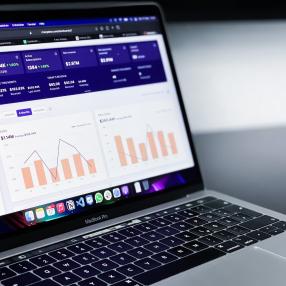Data Integration
Full Service Integration
Integrating solutions can be a time consuming and detail-oriented process. Without a dedicated team, many organizations face project slow downs and missteps. Full-service integration simplifies your project by handling all the prep work, data mapping, testing, and customizing that your integration requires. Let the professionals of StarfishETL handle your project and ensure a successful outcome.
Learn more about
The Intersection of AI and Data Integration and What it Means for your Future Projects
AI and machine learning are making it easier for businesses to leverage their data intelligence and expand on the benefits of integration. Let’s look at how AI and data integration intersect and what those applications might mean for your future projects.
Continue reading
What Drives Up the Cost of Integration? Factors You Should Know
Integration costs aren't always black and white. Avoid any surprises on the price of your integration by being aware of all possible cost drivers. Here are some of the biggest factors that can drive up the cost of integration.
Continue reading
Don't Let These CRM Challenges Hold Your Small Business Back
CRM is a critical component of any business strategy, but small businesses face unique challenges that can prevent them from enjoying its full benefits. By addressing these challenges, small businesses can improve their CRM strategy, enhance customer relationships, and drive sales growth. Overcoming these hurdles takes the right tools, technical resources, and strategies.
Continue reading
Fuel Descriptive, Predictive, and Prescriptive Analytics with Integration
Data-forward businesses use analytics to drive their decision making. The meaning behind those analytics requires teams to look at the past, the present, and the future. That’s where descriptive, predictive, and prescriptive analytics models come into play. Each of these analytics types serves a different purpose and is informed through integration. Let’s look at how we can fuel descriptive, predictive, and prescriptive analytics with integration for streamlined and simplified decision making.
Continue reading
How Sales Leaders Capture More Accurate Reports with StarfishETL
Intelligent reporting helps teams build the most informed approach to their sales strategy. Forecasts, year-over-year sales histories, MQL to SQL conversions, and customer retention rates are just a few of the
report types that educate sales executives on what’s working and what isn’t. Data-centric
businesses use integration strategies to unlock hidden trends and help teams expand those reporting functions. The number of integrations and types of applications you combine are…

How Much Does Data Integration Cost?
If you’ve never performed a data integration before you may be wondering, “How much is this going to cost me?”. Well, that depends. You see, integrations have a lot of moving parts, and each project has its own unique requirements. In addition, where your solution lives and which integration company you work with can also affect the costs. If your solutions are on-premise for example, you must account for the cost of hardware and data backups in addition to your other costs.
Continue reading
5 Ways to Reduce Data Integration Costs
Businesses looking to create these connected processes and streamline automation often integrate, but costs can rack up if the project has poor planning. In this post, we’ll highlight five ways to reduce data integration costs for more thoughtful and successful projects.
Continue reading
How To Prepare For ERP Integration
Enterprise Resource Planning (ERP) is a tool used by businesses to increase efficiency and reach their full potential. It allows companies to automate business functions around supply chains, accounting, human resources, and inventory. The ability to manage these business aspects within a single application lets businesses create a streamlined, standardized view of processes. Companies adopt ERP to gain better pipeline visualization, reduce errors, and manage data in one spot. However, even…
Continue reading
4 Tips for Preserving Data Integrity During Integration
Integrated systems use shared data to fuel analytics, improve big data and AI initiatives, and inform machine learning algorithms. But imagine making major decisions on marketing budgets, sales processes, and customer service programs using completely inaccurate data.
Continue reading
2 Quick Tips to Prepare for HubSpot CRM Integration
Integrating HubSpot CRM is a smart business move. One of HubSpot’s greatest strengths is the diverse swaths of data it makes reportable for smart sales decisions. All of this data is accessed on a user-friendly platform that is easy to learn and capitalize on. When we connect that power to other business systems, we’re furthering the extent of our analytical capabilities and our understanding of our business processes.
Continue reading
How to Discuss Your Integration with Non-Technical Stakeholders
Communicating about integration can sometimes be more difficult than the integration itself. As the integration expert, your job is to make that communication as clear and accessible as possible. Recognize that perspectives are different based on job roles. Barriers to communication exist because you and your stakeholders are viewing the integration through different lenses, not because one of you is smarter or more skilled than the other.
Continue reading
What Every CFO Needs to Know About Integration
Think that a CFO isn’t a major player in an integration? Think again.Companies integrate with the intention of optimizing processes: connecting sales and marketing data to enhance targeting, combining financial systems and CRMs to streamline invoice and payment histories, feeding emails into CRMs to keep accurate data for customer service reps, and more. The CFO plays a role in each of these departments. Digital optimization will trickle down throughout the entire company, and therefore affect…
Continue reading
What StarfishETL’s AI Features Mean for You
StarfishETL, the low-code integration platform known for its user-friendly interface, just announced a game-changer for data analysts and business users: a suite of AI-powered features!
Continue reading
4 Strategies for Integrating Complex Entity Relationships Across Systems
Integration allows these businesses to successfully manage all the moving parts, but the complex entity relationships that come with that integration can get tricky. The StarfishETL team is no stranger to complex integrations, so we are excited to share these four strategies for making your integration journey a little smoother. Let’s go!
Continue reading4 Strategies for Integrating Complex Entity Relationships Across Systems
The StarfishETL team is no stranger to complex integrations, so we are excited to share these four strategies for making your integration journey a little smoother. Let’s go!
Continue reading
Pagination
- Page 1
- Next page
